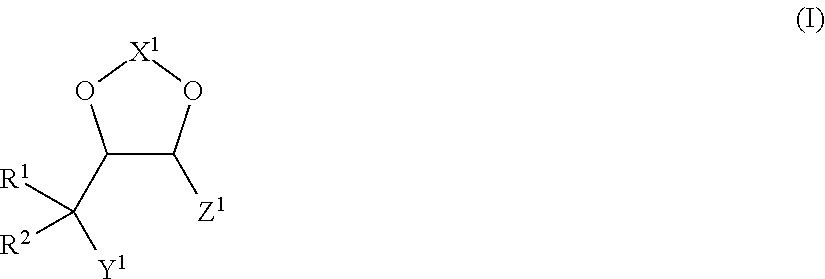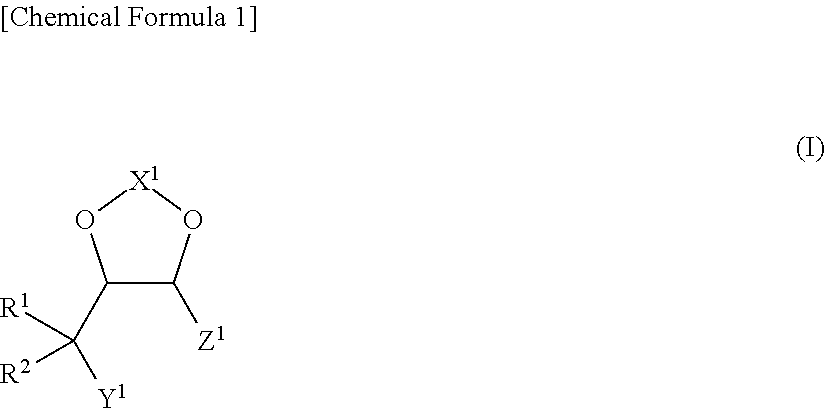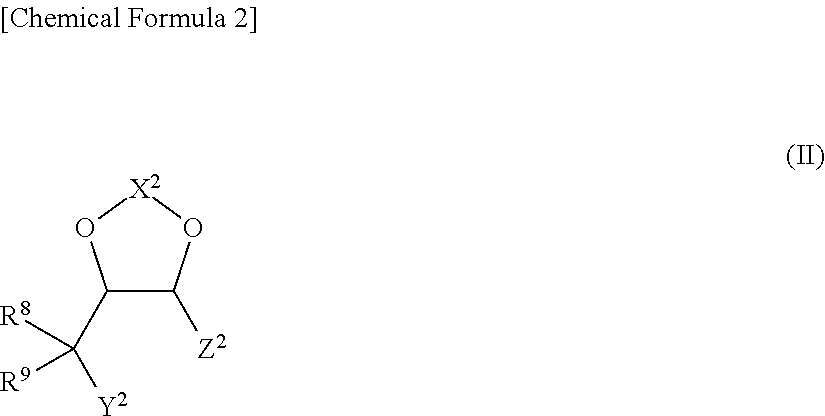Nonaqueous electrolyte solution, electrochemical element using same, and 1,2-dioxypropane compound used in same
- Summary
- Abstract
- Description
- Claims
- Application Information
AI Technical Summary
Benefits of technology
Problems solved by technology
Method used
Image
Examples
synthesis example 1
Synthesis of 4-(methylsulfonylmethyl)-1,3,2-dioxathiolane-2-oxide
[0160]9.00 g (58.4 mmol) of 3-(methylsulfonyl)propane-1,2-diol was dissolved in 100 mL of methylene chloride. 7.64 g (64.2 mmol) of thionyl chloride was dropwise added to the solution at an inner temperature of from 20 to 25° C. After this was stirred at 35° C. for 2 hours, the solvent and the remaining thionyl chloride were evaporated away under reduced pressure to give 11.40 g of a crude crystal. The obtained crude crystal was recrystallized from dimethyl carbonate / 2-propanol to give 6.60 g of the intended 4-(methylsulfonylmethyl)-1,3,2-dioxathiolane-2-oxide as a diastereomeric mixture (mixture ratio 9 / 1) (yield 56%).
[0161]The obtained 4-(methylsulfonylmethyl)-1,3,2-dioxathiolane-2-oxide was analyzed through 1H-NMR and mass spectrometry and its melting point was measured, thereby identifying the structure thereof. The results are shown below.
[0162](1) 1H-NMR (300 MHz, CDCl3): δ=5.48-5.40 (m, 0.9; H), 5.12-5.03 (m, 0....
synthesis example 2
Synthesis of 4-(methylsulfonylmethyl)-1,3-dioxolan-2-one
[0165]5.70 g (37.0 mmol) of 3-(methylsulfonyl)propane-1,2-diol and 17.56 g (220.0 mol) of pyridine were dissolved in 100 mL of methylene chloride, and 20 mL of a toluene solution of 10.97 g (37.0 mmol) of triphosgene was dropwise added to the solution at an inner temperature of from 5° C. to 15° C., taking 30 minutes, and stirred at room temperature for 1 hour. 20 mL of water was added thereto for liquid-liquid separation, and the organic layer was dried with magnesium sulfate and concentrated under reduced pressure. The residue was recrystallized from dimethyl carbonate / acetonitrile to give 1.30 g of the intended 4-(methylsulfonylmethyl)-1,3-dioxolan-2-one (yield 20%).
[0166](1) 1H-NMR (300 MHz, CD3CN): δ=5.22-5.13 (m, 1H), 4.68-4.62 (m, 1H), 4.27 (dd, J=8.79, 7.07 Hz, 1H), 3.72-3.64 (m, 1H), 3.42-3.35 (m, 1H), 2.99-2.98 (m, 3H).
[0167](2) MS (CI): m / z=181 (M+1).
[0168](3) Melting point: 118-120° C.
examples 1 to 14
Comparative Examples 1 to 3
Production of Lithium Ion Secondary Battery
[0169]94% by mass of LiNi1 / 3Mn1 / 3Co1 / 3O2 and 3% by mass of acetylene black (electroconductive agent) were mixed, and added to and mixed in a solution previously prepared by dissolving 3% by mass of polyvinylidene fluoride (binder) in 1-methyl-2-pyrrolidone, thereby preparing a positive electrode mixture paste. The positive electrode mixture paste was applied on one surface of an aluminium foil (collector), then dried, processed under pressure and cutted into a predetermined size, thereby producing a positive electrode sheet. The density of the part of the positive electrode except the collector was 3.6 g / cm3. On the other hand, 95% by mass of artificial graphite (d002=0.335 nm, negative electrode active material) was added to and mixed in a solution previously prepared by dissolving 5% by mass of polyvinylidene fluoride (binder) in 1-methyl-2-pyrrolidone, thereby preparing a negative electrode mixture paste. The n...
PUM
 Login to View More
Login to View More Abstract
Description
Claims
Application Information
 Login to View More
Login to View More - R&D
- Intellectual Property
- Life Sciences
- Materials
- Tech Scout
- Unparalleled Data Quality
- Higher Quality Content
- 60% Fewer Hallucinations
Browse by: Latest US Patents, China's latest patents, Technical Efficacy Thesaurus, Application Domain, Technology Topic, Popular Technical Reports.
© 2025 PatSnap. All rights reserved.Legal|Privacy policy|Modern Slavery Act Transparency Statement|Sitemap|About US| Contact US: help@patsnap.com



